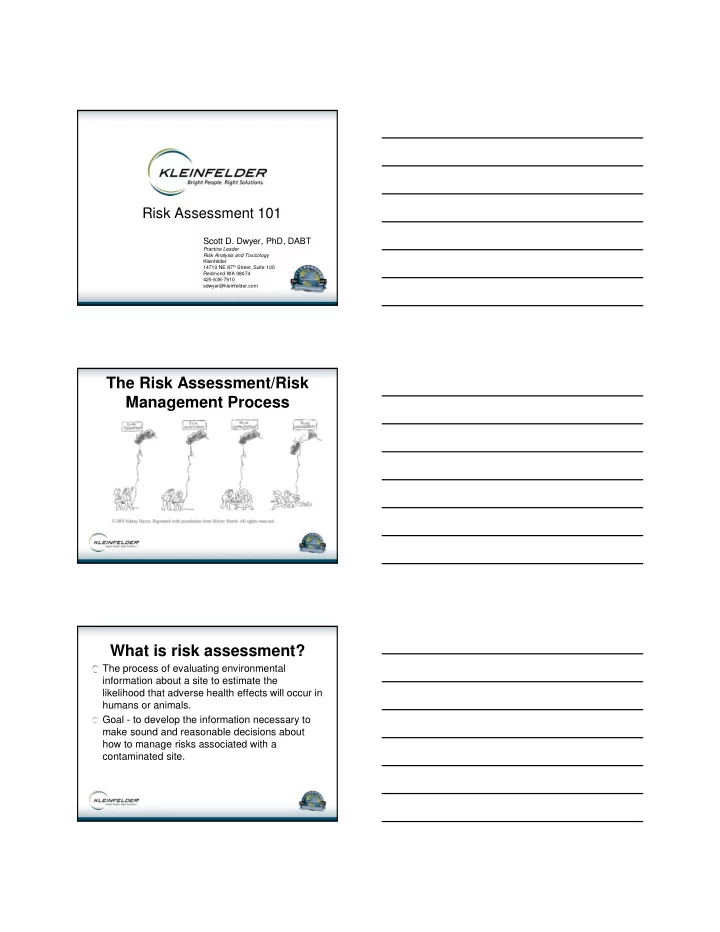

Risk Assessment 101 Scott D. Dwyer, PhD, DABT Practice Leader Risk Analysis and Toxicology Kleinfelder 14710 NE 87 th Street, Suite 100 Redmond WA 98074 425-636-7910 sdwyer@kleinfelder.com The Risk Assessment/Risk Management Process What is risk assessment? The process of evaluating environmental information about a site to estimate the likelihood that adverse health effects will occur in humans or animals. Goal - to develop the information necessary to make sound and reasonable decisions about how to manage risks associated with a contaminated site.
Value of Risk Assessment Sound scientific basis for deciding whether remediation is necessary Sound scientific basis for deciding how much remediation is necessary Value of a Risk Assessment Risk = Hazard x Outrage --Peter Sandman When to do a risk assessment… Negotiate closure Permitting Terminate remediation Real estate transactions Legal/Litigation support Air quality – industrial emissions Consumer products New markets
What is risk management? Approaches or methods to prevent or reduce exposure to chemicals (in the environment). A risk management plan is based on a risk assessment. Basic Risk Assessment Concepts “The dose makes the poison” - Paracelsus Question: Is the consumption of 500 aspirin lethal? Basic Risk Assessment Concepts “The dose makes the poison” - Paracelsus Question: Is the consumption of 500 aspirin lethal? Answer: Not if you take only one per day.
Basic Risk Assessment Concepts No Exposure = No Risk Risk Assessment Approach Screening-level risk assessment (Tier 1) is there a problem? Baseline Risk Assessment (Tier 2, Tier 3) how serious is the problem? Risk Management what are we going to do about the problem? Screening Level Risk Assessment
Screening-level Risk Assessment Compare maximum concentrations of contaminants to risk-based concentrations. EPA Regional Screening Levels (formerly PRGs) Texas Risk-Based Exposure Limits (RBELs) Texas Protective Concentration Levels (PCLs) California CHHSLs Decision if concentration < screening level = no further action (NFA) if concentration > screening level = risk assessment or remediation Baseline Risk Assessment Identify chemicals of concern Which chemicals are we worried about? Exposure Assessment How will people be exposed and to how much? Toxicity Assessment What effects at what doses? Risk Characterization Quantify risk or hazard Identification of Chemicals of Concern Purpose - to select chemicals that will be evaluated in the risk assessment Approach Eliminate lab contaminants Frequency of detection Compare inorganics to natural background
Exposure Assessment Identify exposed populations Identify exposure pathways Estimate exposure point concentrations Estimate chemical intake (dose) Estimate Exposure Point Concentrations Calculate mean concentration in each medium (soil, water, air) this is the average (central tendency) exposure Calculate 95th percentile UCL this is the reasonable maximum exposure (RME) Estimate Intake (Dose) Use default assumptions Use site-specific assumptions Need estimates of: intake rate (soil, water, air) concentration how frequent (exposure frequency) how long (exposure duration)
Generic Intake (Dose) Equation Where: C = exposure point concentration IR = intake rate (soil or water ingestion, etc.) EF = exposure frequency (days per year) ED = exposure duration (years) BW = estimated body weight AT = averaging time Toxicity Assessment Toxicity Assessment Collect toxicity values Noncancer Reference Doses (RfDs) Cancer Slope Factors (SFs) Sources – IRIS, PPRTVs, HEAST, ATSDR Describe toxicology of chemicals of concern
Risk Characterization Quantifying Risk and Hazard Exposure Assessment: estimate of intake Toxicity Risk Assessment: Characterization: slope factor or cancer risk or RfD noncancer hazard Risk Characterization Integrate exposure and toxicity assessments Quantify risk and hazard from individual chemicals Sum risk and hazard from multiple chemicals Sum risk and hazard across exposure pathways Discuss uncertainty
Quantifying Risk and Hazard (Carcinogens) 1. From Exposure Assessment - Estimate Intake (dose) Intake = (C x IR x EF x ED)/(BW x AT) Intake = (100 mg/kg x 100 mg/d x 350 d/yr x 30 y)/(70 kg x 25,550 d) Intake = 0.0000587 mg/kg-day 2. From Toxicity Assessment - Find Cancer Slope Factor Example: Benzene, 0.029 (mg/kg-day) -1 3. Risk Characterization (Calculate Cancer Risk) Cancer Risk = Intake x SF = 0.0000587 x 0.029 = 2 x 10 -6 Quantifying Risk and Hazard (Noncarcinogens) 1. Intake = 0.0137 mg/kg-day 2. From Toxicity Assessment - Find RfD Example: Toluene, 0.2 mg/kg-day 3. Risk Characterization (Calculate Noncancer Hazard Quotient) HQ = (0.0137 mg/kg-day)/(0.2 mg/kg-day) = 0.069 Results of Risk Assessment If cancer risk < 1 x 10 -6 , no further action If cancer risk > 1 x 10 -6 , further investigation or risk management If hazard quotient < 1.0, no further action If hazard quotient > 1.0, further investigation or risk management
Risk Management Risk Management Options No Further Action Source Control Deed Restrictions, Institutional Controls Remediation Calculating Remediation Goals Provides a screening level for evaluation of a site during the investigation Establishes a soil or water concentration for a given hazard or risk level Provides a target for remediation
Calculating Remediation Goals Information Needed: Target hazard or risk level (e.g., hazard quotient = 1 or cancer risk = 1 x 10 -6 ) RfD for noncancer hazard, or SF for cancer risk Exposure assumptions Calculating Remediation Goals (Noncancer) C = (THQ x BW x AT x RfD)/(EF x ED x IR) C = remediation goal in soil (mg/kg) or water (mg/L) THQ = target hazard quotient BW = body weight (kg) AT = averaging time (days) RfD = reference dose (mg/kg-day) EF = exposure frequency (days/year) ED = exposure duration (years) IR = intake rate (mg/day, soil; L/day, water) Calculating Remediation Goals (Cancer) C = (TR x BW x AT)/(EF x ED x IR x SF) C = remediation goal in soil (mg/kg) or water (mg/L) TR = target cancer risk BW = body weight (kg) AT = averaging time (years) EF = exposure frequency (days/year) ED = exposure duration (years) IR = intake rate (mg/day, soil; L/day, water) SF = slope factor (1/mg/kg-day)
Final Thoughts…
Recommend
More recommend